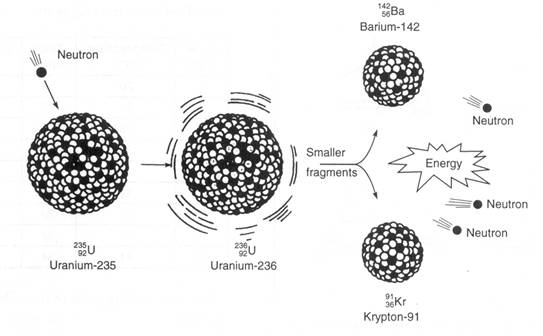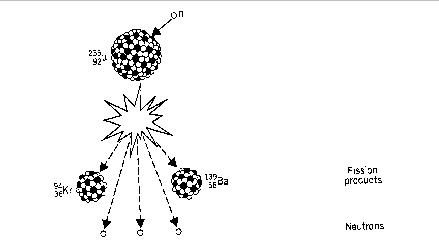Time Travel Research Center © 2005 Cetin BAL - GSM:+90 05366063183 - Turkey/Denizli
Fission
In fission, a heavy nucleus absorbs a neutron and breaks apart to give back
lighter nuclei plus 2 or more neutrons and some energy. Room temperature or
slow thermal neutrons have enough kinetic energy to approach a nucleus of
U-235. Lise Meitner and Otte Frisch were able to show that one of the rare
isotopes, U-235, was able to split into roughly two equal parts. This they
termed nuclear fission.

23592U + 10n -----> 23692U
-----> X + Y + b no
X + Y can be anything, but are usually in the midrange of mass numbers. The
factor 'b' in this equation has a value of 2.47 which is the average of many
fissions. When the U-235 is struck by the slow thermal neutron it becomes
the unstable U-236. This U-236 fissions into Kr and Ba (most often) isotopes
with the same no/p+ ratio as the U-236. This ratio is
to high for the Kr and Ba and therefore they must eject no of a
higher energy then the initial slow thermal neutrons.
An isotope capable of undergoing fission is called a fissile isotope. Only U-235 is a natural fissile isotope. U-233 and Pu-239 are synthetic fissile isotopes. Since each fission results in 2 or 3 no and, if these can be slowed down by collisions with their surroundings, then the potential for a nuclear chain reaction exists. A chain reaction is a self-sustaining process whereby products from one event cause one or more new events. If the mass of U-235 is small enough, the loss of no to the surroundings is to rapid to initiate chaining.


However, at the critical mass the loss is small. Most of the neutrons
get trapped and strike other fissile nuclei. The result is a virtually
instantaneous fission of the entire sample. An atomic bomb filled with
weapons grade U-235 is essentially only 2 subcritical masses with an
explosive trigger which drives them together. The explosion forces the sub-critical
masses together and not only creates a critical mass but continues to
compress the mass into an even more dense state. Any neutrons released
spontaneously will not escape and start the chain reaction.
A reactor cannot be made to fission like a bomb. The bomb requires pure
U-235 or Pu-239. The concentration of fissile isotopes in a reactor is only
2-4% with much of the remainder being U-238 (non-fissile). Even if all the
fuel melted into a pool at the bottom of the reactor chamber (The China
Syndrome) there would not be enough U-235 to form a critical mass. To have
controlled fission take place in a reactor, the leakage of neutrons away
from the core must be controlled, and the fast neutrons produced by fission
must be slowed. Leakage occurs at the surface of the core, whereas no
are generated throughout the volume of the core. By making the fuel core
large enough, the ratio of surface area to volume can be reduced to where
enough neutrons are retained to cause further fission events. To slow
neutrons down, the fuel core is provided with a moderator. Water
itself is a good moderator and D2O is used in the CANDU reactors.
Graphite is also a good moderator and it was in use in the Chernobyl reactor.
The safe operation of a reactor requires that the multiplication of slow
neutrons be controlled throughout the fission cycle. This cycle begins with
the fission of a U-235 nuclei and the production of fast neutrons, their
moderation and the use of the survivors of the moderation to launch
additional fission events. The ratio of neutrons at the end of the cycle to
those that started it is called the multiplication factor, k. For smooth
safe, continuous operation, the value of k in the reactor should be exactly
1. When it is, the reactor is critical. When k>1 fission is
accelerating and the reactor is supercritical. When k<1, fission is
slowing down and the reactor is subcritical. The reactor must have a
built-in ability to go supercritical and then be controlled. The system uses
cadmium control rods to capture neutrons to keep the reactor at the desired
level of criticality. The nuclear fuel is in the form of sintered pellets of
uranium or plutonium oxide. These pellets are packed into cladding tubes
made of zirconium alloy. These zirconium alloy tubes must be gas proof to
prevent the escape of any gaseous radioactive wastes. As fission continues
the wastes build-up in the cladding tubes and poison the U-235 still
left. This slows the rate of fission. Only 3% of the U-235 in a tube
actually fissions before it must be replaced. They still contain 97% of the
original U-235 and newly synthesized Pu-239 made from U-238.
Alıntı: http://www.ucdsb.on.ca/tiss/stretton/chem2/nuc10.htm
Hiçbir yazı/ resim izinsiz olarak kullanılamaz!! Telif hakları uyarınca bu bir suçtur..! Tüm hakları Çetin BAL' a aittir. Kaynak gösterilmek şartıyla siteden alıntı yapılabilir.
The Time Machine Project © 2005 Cetin BAL - GSM:+90 05366063183 -Turkiye/Denizli
Ana Sayfa /İndex /Roket bilimi / ![]() E-Mail /CetinBAL /Quantum Teleportation-2
E-Mail /CetinBAL /Quantum Teleportation-2
Time Travel Technology /Ziyaretçi Defteri / Duyuru / UFO Technology